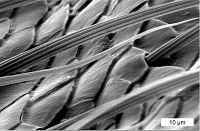
Misfit scales found on the lantern of the Photuris firefly. Researchers found that the sharp edges of the scales let out the most light. Credit: Optics Express.
Scientists have long known the chemical basis for the bioluminescence of creatures such as fireflies, but few have studied the optical structures that enable these glowing organisms to send out their signals. Little was also known about the external efficiency of this light emission—specifically, how the insects evolved to reduce the total internal reflection of the emitted light at large incidence angles.
Annick Bay, a doctoral student at the University of Namur (Belgium), and her colleagues studied the morphology of the segments of the luminescent abdomens of fireflies of the genus Photuris, native to Panama. They modeled the propagation of light of 560 nm, close to the peak wavelength of the flies’ emission, within these structures, and they experimentally checked their calculations by measuring the radiance of light beamed through pieces of the insects’ abdomens.
The team, which included researchers from the European Synchrotron Research Facility (Grenoble, France), found that Photuris has “misfit” chitin scales, with one edge of each scale protruding a few microns outward. The scales create a corrugated surface that improves light extraction from the abdomen by 9.5 percent over a flat surface with the same refractive index. The presence of nearly spherical organelles called peroxisomes in the photocytes, or light-generating cells, creates a disordered structure that helps to lower the refractive index of the bioluminescent interior of the abdomen, though this has a lesser effect on the firefly’s external efficiency than the corrugation of the scales.
Next, the research team—joined by scientists from the University of Sherbrooke (Canada)—applied the firefly findings to the overlayer of a gallium nitride LED. Adjusting for the shorter peak-emission wavelength (425 nm) and the high refractive index (2.53) of the GaN, the researchers built up a “factory-roof” layer of photoresist on top of an already manufactured LED; the silhouette of the layer looks like a row of right triangles just touching each other at one tip. The gain in light-extraction efficiency from the corrugated overlayer was even greater than the gain from the misfit scales of the original firefly that inspired the project.
